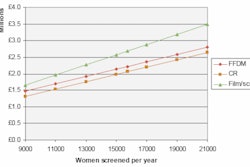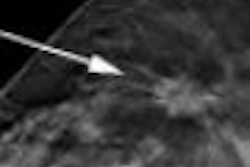Computer-aided detection (CAD) for mammography screening has taken its share of criticism recently, particularly following the publication of a negative study in the New England Journal of Medicine last year. A new study published this week in NEJM, however, has found that the use of CAD with a single reader can achieve performance comparable to double reading with two radiologists.
In last year's study, a team led by Dr. Joshua Fenton of the University of California, Davis, found that the use of CAD for mammography screening negatively affected diagnostic accuracy due to the higher number of false positives the software produced. CAD also failed to have a statistically significant effect on sensitivity in the study.
CAD fared much better in this week's study, which suggests that single reading with the technology is comparable to double reading (NEJM, October 16, 2008, Vol. 359:16, pp. 1675-1684). The paper details the results of a team led by Dr. Fiona Gilbert from the University of Aberdeen in Scotland; Gilbert and colleagues conducted a multicenter study of CAD as part of the Computer-Aided Detection Evaluation Trial II (CADET II).
CADET II's goal was to determine whether the performance of a single reader using CAD would match that of two readers. Double reading is standard practice in many European countries, the group wrote, but not in the U.S. It has been shown to increase the rate of cancer detection by 4% to 14%.
"Our study is important as it provides evidence that an expert using CAD can match the performance achieved by double reading," Gilbert told AuntMinnie.com. "Many countries use double reading as their standard and this provides a safe alternative way of working without compromising cancer detection rates. The caveat is that like many studies of CAD we found an increased recall rate using CAD compared to double reading. We believe that arbitration should be done when using CAD so that the recall rates can be kept low."
The team used ImageChecker DMax version 8.1 (Hologic, Bedford, MA) and viewed images on a CheckMate flat-panel display screen. Films were read by 17 radiologists, two breast cancer clinicians, and eight radiographers (radiologic technologists) trained in film interpretation.
Mammography exams included in the study were assigned to three groups:
- Group A, with 1,152 subjects, received double reading only
- Group B, with 1,182 subjects, received single reading with CAD only
- Group C, with 28,723 subjects, received both
The researchers found 227 cancers in Group C, for an overall screening detection rate of 8.0 per 1,000. They found 12 cancers in Group A (10.4 per 1,000) and eight cancers in Group B (6.8 per 1,000).
The team compared recall rates, sensitivity, specificity, and positive predictive values (PPV):
|
The cancer detection rate after single reading with CAD and double reading proved comparable at 7.02 and 7.06 per 1,000, respectively. Single reading with CAD had a 0.5% higher recall rate than double reading.
"The sensitivity values are overestimates, because data on interval cancers (cancers detected within one year after a negative mammography result) were not yet available for all subjects," the group wrote. "The same interval cancers were missed by both regimens, and hence the difference in sensitivity will remain the same in both regimens."
Gilbert and her team concluded that single reading with CAD is an alternative to double reading, and that whether to adopt it remains a question of cost-effectiveness, with the cost of the CAD device and associated increased recall rates balanced against savings in reader time.
"Double reading, which is recognized as the best method for the detection of small invasive cancers, is often difficult to achieve in practice because of costs and the need for two readers," they wrote. "Where single reading is standard practice, computer-aided detection has the potential to improve cancer-detection rates to the level achieved by double reading."
By Kate Madden Yee
AuntMinnie.com staff writer
October 2, 2008
Related Reading
Study finds that CAD improves mammography's sensitivity, February 13, 2008
Mammo CAD results show reproducibility in serial exams, January 10, 2008
UnitedHealthcare postpones CAD decision, November 27, 2007
CAD vs. radiologist second reads: What's better for screening mammograms? November 16, 2007
UnitedHealthcare ponders cuts to CAD reimbursement, October 26, 2007
Copyright © 2008 AuntMinnie.com



















